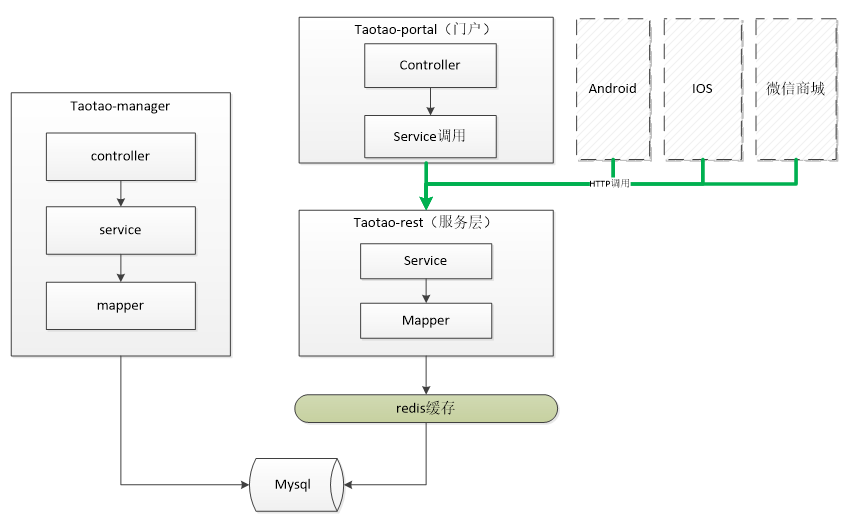Spring和Jedis结合配置:
Jedis连接池的配置:
<!-- 连接池配置 -->
<bean id="jedisPoolConfig" class="redis.clients.jedis.JedisPoolConfig">
<!-- 最大连接数 -->
<property name="maxTotal" value="30" />
<!-- 最大空闲连接数 -->
<property name="maxIdle" value="10" />
<!-- 每次释放连接的最大数目 -->
<property name="numTestsPerEvictionRun" value="1024" />
<!-- 释放连接的扫描间隔(毫秒) -->
<property name="timeBetweenEvictionRunsMillis" value="30000" />
<!-- 连接最小空闲时间 -->
<property name="minEvictableIdleTimeMillis" value="1800000" />
<!-- 连接空闲多久后释放, 当空闲时间>该值 且 空闲连接>最大空闲连接数 时直接释放 -->
<property name="softMinEvictableIdleTimeMillis" value="10000" />
<!-- 获取连接时的最大等待毫秒数,小于零:阻塞不确定的时间,默认-1 -->
<property name="maxWaitMillis" value="1500" />
<!-- 在获取连接的时候检查有效性, 默认false -->
<property name="testOnBorrow" value="true" />
<!-- 在空闲时检查有效性, 默认false -->
<property name="testWhileIdle" value="true" />
<!-- 连接耗尽时是否阻塞, false报异常,ture阻塞直到超时, 默认true -->
<property name="blockWhenExhausted" value="false" />
</bean> 对于单机版的配置:
<!-- jedis单机版-->
<bean id="redisClient" class="redis.clients.jedis.JedisPool">
<constructor-arg name="host" value="192.168.59.129"></constructor-arg>
<constructor-arg name="port" value="6379"></constructor-arg>
<constructor-arg name="poolConfig" ref="jedisPoolConfig"></constructor-arg>
</bean>
<bean id="jedisClient" class="com.newstyles.rest.dao.Impl.JedisClientSingle">
</bean>集群版的配置:
<!-- jedis集群版 -->
<bean id="redisClient" class="redis.clients.jedis.JedisCluster">
<constructor-arg name="nodes">
<set>
<bean id="redis01" class="redis.clients.jedis.HostAndPort">
<constructor-arg name="host" value="192.168.59.129"></constructor-arg>
<constructor-arg name="port" value="7001"></constructor-arg>
</bean>
<bean id="redis02" class="redis.clients.jedis.HostAndPort">
<constructor-arg name="host" value="192.168.59.129"></constructor-arg>
<constructor-arg name="port" value="7002"></constructor-arg>
</bean>
<bean id="redis03" class="redis.clients.jedis.HostAndPort">
<constructor-arg name="host" value="192.168.59.129"></constructor-arg>
<constructor-arg name="port" value="7003"></constructor-arg>
</bean>
<bean id="redis04" class="redis.clients.jedis.HostAndPort">
<constructor-arg name="host" value="192.168.59.129"></constructor-arg>
<constructor-arg name="port" value="7004"></constructor-arg>
</bean>
<bean id="redis05" class="redis.clients.jedis.HostAndPort">
<constructor-arg name="host" value="192.168.59.129"></constructor-arg>
<constructor-arg name="port" value="7005"></constructor-arg>
</bean>
<bean id="redis06" class="redis.clients.jedis.HostAndPort">
<constructor-arg name="host" value="192.168.59.129"></constructor-arg>
<constructor-arg name="port" value="7006"></constructor-arg>
</bean>
</set>
</constructor-arg>
<constructor-arg name="poolConfig" ref="jedisPoolConfig"></constructor-arg>
</bean>
<bean id="jedisClientCluster" class="com.newstyles.rest.dao.Impl.JedisClientCluster">
</bean>当然,上述两种方式只能有一种存在,但是连接池时必须保留的,其规定了Jedis运行时候的相关的设置,在这个测试实例中,我们采用了Jedis单机版的方式完成这个工程,所以,应该讲集群版的注释掉。
单机版测试案例:
public void testSpringJedisSingle() {
ApplicationContext applicationContext = new ClassPathXmlApplicationContext("classpath:spring/applicationContext-*.xml");
JedisPool pool = (JedisPool) applicationContext.getBean("redisClient");
Jedis jedis = pool.getResource();
String string = jedis.get("key1");
System.out.println(string);
jedis.close();
pool.close();
}
集群版测试案例:
public void testSpringJedisCluster() {
ApplicationContext applicationContext = new ClassPathXmlApplicationContext("classpath:spring/applicationContext-*.xml");
JedisCluster jedisCluster = (JedisCluster) applicationContext.getBean("redisClient");
String string = jedisCluster.get("key1");
System.out.println(string);
jedisCluster.close();
}
在这里我们测试过后,以Jedis单机版为例,整合到Spring框架中:
Dao层:
首先定义了一个接口,虽说以Jedis单机版为例子,但是我们同时也实现了Redis的集群版的实例的完成:
首先在JedisClient接口中定义了Jedis客户端常用到的操作:
public interface JedisClient {
String get(String key);
String set(String key, String value);
String hget(String hkey,String key);
long hset(String hkey,String key,String value);
long incr(String key);
long expire(String key,int second);
long ttl(String key);
long del(String key);
long hdel(String hkey ,String key);
}首先,单机版的Jedis客户端的实现:
/**
* 单机版
* @author ***********
*
*/
public class JedisClientSingle implements JedisClient {
//需要JedisPool这个类型的对象来进行操作
@Autowired
private JedisPool jedisPool;
@Override
public String get(String key) {
Jedis jedis = jedisPool.getResource();
String string = jedis.get(key);
jedis.close();
return string;
}
@Override
public String set(String key, String value) {
Jedis jedis = jedisPool.getResource();
String string = jedis.set(key,value);
jedis.close();
return string;
}
@Override
public String hget(String hkey, String key) {
Jedis jedis = jedisPool.getResource();
String string = jedis.hget(hkey,key);
jedis.close();
return string;
}
@Override
public long hset(String hkey, String key, String value) {
Jedis jedis = jedisPool.getResource();
long result = jedis.hset(hkey,key,value);
jedis.close();
return result;
}
@Override
public long incr(String key) {
Jedis jedis = jedisPool.getResource();
long result = jedis.incr(key);
jedis.close();
return result;
}
@Override
public long expire(String key, int second) {
Jedis jedis = jedisPool.getResource();
long result = jedis.expire(key, second);
jedis.close();
return result;
}
@Override
public long ttl(String key) {
Jedis jedis = jedisPool.getResource();
long result = jedis.ttl(key);
jedis.close();
return result;
}
@Override
public long del(String key) {
Jedis jedis = jedisPool.getResource();
long result = jedis.del(key);
jedis.close();
return result;
}
@Override
public long hdel(String hkey, String key) {
Jedis jedis = jedisPool.getResource();
long result = jedis.hdel(hkey,key);
jedis.close();
return result;
}
}集群版Redis客户端的实现:
/**
* 集群版
* @author ***************
*
*/
public class JedisClientCluster implements JedisClient{
@Autowired
private JedisCluster jedisCluster;
@Override
public String get(String key) {
return jedisCluster.get(key);
}
@Override
public String set(String key, String value) {
return jedisCluster.set(key, value);
}
@Override
public String hget(String hkey, String key) {
return jedisCluster.hget(hkey, key);
}
@Override
public long hset(String hkey, String key, String value) {
return jedisCluster.hset(hkey, key, value);
}
@Override
public long incr(String key) {
return jedisCluster.incr(key);
}
@Override
public long expire(String key, int second) {
return jedisCluster.expire(key, second);
}
@Override
public long ttl(String key) {
return jedisCluster.ttl(key);
}
@Override
public long del(String key) {
return jedisCluster.del(key);
}
@Override
public long hdel(String hkey, String key) {
return jedisCluster.hdel(hkey, key);
}
}两者实现的最主要的区别在于单机版利用的是JedisPool来获取Jedis客户端的实例,而集群版则是利用JedisCluster来获取,获取使用的实例,其方法的包装和调用东较为相似,虽然实现原理不同,但是对于Jedis的使用,使用上述接口定义的操作,则能够满足呀大部分的操作。
Service层:
定义一个接口ContentService接口,其中定义了获取ContentList的操作:
public interface ContentService {
List<TbContent> getContentList(long contentCid);
}随后实现这个接口:
@Service
public class ContentServiceImpl implements ContentService {
@Autowired
private JedisClient jedisClient;
@Autowired
private TbContentMapper contentMapper;
@Value("${INDEX_CONTENT_REDIS_KEY}")
private String INDEX_CONTENT_REDIS_KEY;
@Override
public List<TbContent> getContentList(long contentCid) {
//缓存的添加不能影响正常的业务逻辑
//1.从缓存中取内容
try{
String reslut = jedisClient.hget(INDEX_CONTENT_REDIS_KEY,contentCid+"");
if(!StringUtils.isBlank(reslut)){
List<TbContent> resultList = JsonUtils.jsonToList(reslut, TbContent.class);
return resultList;
}
}catch(Exception e){
e.printStackTrace();
}
//根据内容分类id查询列表
TbContentExample example = new TbContentExample();
Criteria criteria = example.createCriteria();
criteria.andCategoryIdEqualTo(contentCid);
List<TbContent> list = contentMapper.selectByExample(example);
//2.向缓存中添加内容
try{
//将list转换成字符串
String cacheString = JsonUtils.objectToJson(list);
jedisClient.hset(INDEX_CONTENT_REDIS_KEY, contentCid+"", cacheString);
}catch(Exception e){
e.printStackTrace();
}
return list;
}
}其中那些使用Value获取的值都统一定义在一个properties文件中:
#首页内容信息在redis中存储保存的key
INDEX_CONTENT_REDIS_KEY = INDEX_CONTENT_REDIS_KEYController层:
@Controller
@RequestMapping("/content")
public class ContentController {
@Autowired
private ContentService contentService;
@RequestMapping("/list/{contentCategoryId}")
@ResponseBody
public NewstylesResult getContentList(@PathVariable long contentCategoryId){
try{
List<TbContent> list = contentService.getContentList(contentCategoryId);
return NewstylesResult.ok(list);
}catch(Exception e){
e.printStackTrace();
return NewstylesResult.build(500, ExceptionUtil.getStackTrace(e));
}
}
}测试一下:
可以看到,发布的rest服务能够正常的调用。
缓存同步:
先观察下面的流程图:
可以看到,我们所调用的服务都经过rest层,那么如何才能够实现在整个工程中既不影响正常的业务逻辑,又能够很好的进行同步更新,也是实说,在taotao-rest工程中发布一个服务。当后台管理系统修改内容后,调用此服务,同步缓存。要求是当后台中对某些有关于redis缓存中的内容进行更新时,也要更新redis缓存。
Dao层:
使用上一步实现的JedisClient来实现(以单机版Jedis为例)。
Service层:
接收内容分类id,调用dao删除redis中对应的hash中key为分类id的项。
参数:内容分类id
返回值:NewstylesResult
定义一个RedisService接口,定义一个同步的操作:
public interface RedisService {
NewstylesResult syncContent(long contentCid);
}
实现这个接口:
@Service
public class RedisServiceImpl implements RedisService {
@Autowired
private JedisClient jedisClient;
@Value("${INDEX_CONTENT_REDIS_KEY}")
private String INDEX_CONTENT_REDIS_KEY;
@Override
public NewstylesResult syncContent(long contentCid) {
try{
jedisClient.hdel(INDEX_CONTENT_REDIS_KEY, contentCid+"");
}catch(Exception e){
e.printStackTrace();
return NewstylesResult.build(500, ExceptionUtil.getStackTrace(e));
}
return NewstylesResult.ok();
}
}
Controller层:
/**
* 缓存同步Controller
* @author ***********
*
*/
@Controller
@RequestMapping("/cache/sync")
public class RedisController {
@Autowired
private RedisService redisService;
@RequestMapping("/content/{contentCid}")
@ResponseBody
public NewstylesResult contentCacheSync(@PathVariable long contentCid ){
NewstylesResult result = redisService.syncContent(contentCid);
return result;
}
}测试后,发现服务可以进行,但是我们还需要我们的后台当发生适应的条件时进行调用此服务,所以我们还需要在后台的工程中添加一个调用的服务,此服务的调用则是在后台的插入的方法中添加的:所以当有变化的时候删除原来的缓存,添加变化后的新元素,删除的时候也会调用,删除原来的缓存。newstyles-manager-web工程Service层中的有关缓存的修改:
首先插入:
@Override
public NewstylesResult insertContent(TbContent content) {
//补全POJO的内容
content.setCreated(new Date());
content.setUpdated(new Date());
contentMapper.insert(content);
//添加同步缓存逻辑
try{
HttpClientUtil.doGet(REST_BASE_URL+REST_CONTENT_SYNC_URL + content.getCategoryId());
}catch(Exception e){
e.printStackTrace();
}
return NewstylesResult.ok();
} @Override
public NewstylesResult deleteContentById(String ids){
String a[] =ids.split(",");
if(a.length != 0){
for(int i=0;i<a.length;i++){
TbContent tbContent = contentMapper.selectByPrimaryKey(Long.parseLong(a[i].trim()));
try {
pictureService.deleteFilesPic(tbContent.getPic());
pictureService.deleteFilesPic(tbContent.getPic2());
HttpClientUtil.doGet(REST_BASE_URL+REST_CONTENT_SYNC_URL + tbContent.getCategoryId());
} catch (Exception e) {
e.printStackTrace();
}
contentMapper.deleteByPrimaryKey(Long.parseLong(a[i].trim()));
}
}else{
return NewstylesResult.build(500,"Misserror");
}
return NewstylesResult.ok();
}
























 4539
4539











 被折叠的 条评论
为什么被折叠?
被折叠的 条评论
为什么被折叠?








